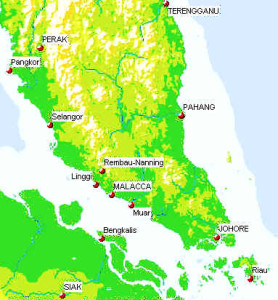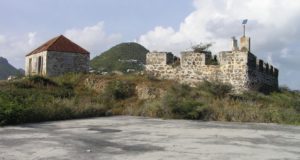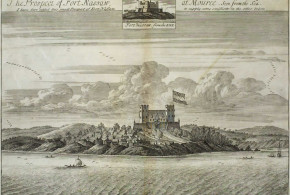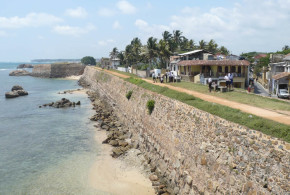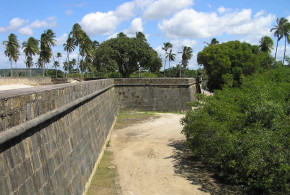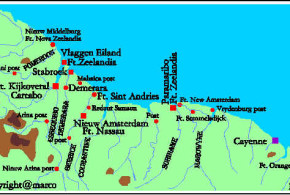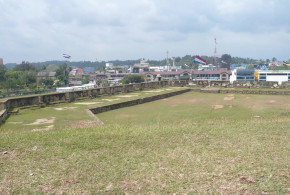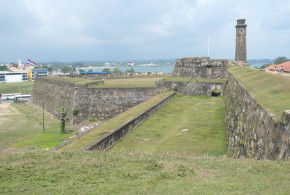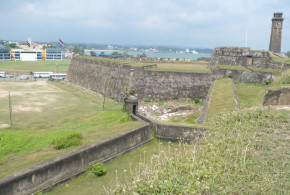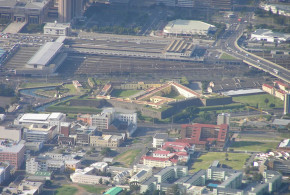Written by Marco Ramerini. English text revision by Dietrich Köster.
On 14 January 1641 the Dutch took possession from the Portuguese of the fortress of Malacca with the help of their ally the Sultan of Johore. The Dutch had treaties with the Johore Sultans to get rid of the Portuguese. The Malays were confident of a victory with the help of the Dutch, thus regaining the Malacca throne. But this was not the Dutch aim.
After the capture the Dutch set up a government. Malacca was too important for the VOC strategies, as the city was situated on the main trade route to the Far East (Spices islands, China and Japan) and was a formidable strategic outpost. A short time after the conquest of Malacca the Dutch made trading agreements with several states of the Malay Peninsula to obtain tin (Kedah 1642, Ujung Salang 1643, Bangkeri 1645, Perak). For this reason a Dutch outpost was established in Perak, but in 1651 the garrison was killed and the outpost destroyed by the Malays. In 1660 even the factory established at Ujung Salang was abandoned.
In the 1650s a great imposing building, the Stadthuys, is built by the Dutch as the administrative centre and home of the Governor of Malacca. By the 1660s the trade in Dutch Malacca was in decline and the relations with the Malay states had deteriorated as well. The Dutch had a factory at Bengkalis (1670s) at the mouth of the Siak river (Sumatra). From here they controlled the tin trade.
The trade at Siak was vital for Malacca and for the Malacca Freeburghers community, a community of Dutch and Portuguese descendants intermarried with the local people. The duty collected of their Siak trade was an important share of Malacca’s revenue.
Perak was the main tin producing kingdom on the whole peninsula and the VOC was interested in controlling its trade. For this reason a Dutch outpost was established from 1670 to 1690 at Teluk Gedung on pulau Pangkor. This fort was reoccupied by the Dutch in 1746 and later the same year the fort was moved upstream to Tanjung Putus.
Malacca trade quickly declined after the Dutch conquest. In fact the city’s prosperity was supported by free trade. However, to the contrary, the VOC wanted the monopoly for all goods. Malacca’s decline was also due to the fact that, while under the Portuguese rule the city was only behind Goa the main Portuguese base in the east. Under the Dutch Batavia was the main Eastern base of the VOC and the company had no interest in developing Malacca’s trade to the detriment of that of Batavia. The Sultanate of Johore (the Dutch ally during the siege of Portuguese Malacca) took advantage of all this by opening his seaport of Riau (an Indonesian island near Singapore) to all ships and to all types of commerce.
In the 1700s Johore was a powerful force on the Straits. The trade of Riau (the seaport for the Johore Sultanate) had far surpassed that of Malacca. The VOC maintained the alliance with Johore despite the discontent of Malacca. The strength of Johore was seen as a safeguard to the peaceful trade on the Straits. In those years it was rumored that the Dutch might leave the city. The only importance of Malacca for the Dutch was that it was situated on a very strategic point and they did not want Malacca to fall into the hands of any other European power; this is why the Dutch remained. During the period of Dutch rule Malacca had a garrison of usually less than 550 Dutchmen.
In 1710 St. Peter’s Church is built. It is still the oldest functioning Christian church in Malaysia. In the 1720s a new power appeared on the scene: the Bugis. They were and are the main ethnic group of the south-western coastal region of Sulawesi (Celebes). After the Dutch conquest of the Sultanate of Makassar several groups of Bugis emigrated from Makassar (Sulawesi) and settled near Malacca in the 1710s. In 1722 the Bugis captured the port of Riau and the whole Kingdom of Johore. The Bugis developed not only the port of Riau but also that of Selangor (north of Malacca). In 1710 the St. Peter’s Church is built. It is the oldest still functioning Christian church in Malaysia. In 1722 the Bugis captured the port of Riau and the whole Kingdom of Johore. The Bugis developed not only the port of Riau but also that of Selangor (north of Malacca).
In 1746 the Sultan of Johore gave the Siak Kingdom to the VOC as a gift. The same year agreements were concluded with the peninsular Kingdoms of Nanning, Rembau and Perak. In Perak the Dutch fort was reoccupied. With these agreements the prosperity of Malacca was improved. However, the Bugis were a constant threat to the Dutch. Their leader Daeng Kamboja made Linggi his base and from October 1756 till July 1757 besieged Dutch Malacca. In February 1757 reinforcements arrived from Batavia and the Bugis were forced to drop the siege. In that year the Dutch built a fort on the Linggi River and named it Philippe (today’s Kota Linggi) after the daughter of the Dutch Governor Jacob Mussel (Governor of Batavia from 1750 to 1761). Tin that was transported from Linggi, Rembau and Kelang Selan. The purpose of the fort was to collect taxes from the tin that was transported from Linggi, Rembau and Kelang Selangor. On the 1st of January 1758 this fort was the site where the treaty between the Bugis and the Dutch was signed. This treaty enabled the Dutch to impose their control on this area: Linggi and Rembau were ceded to the VOC. In 1758 on Pulau Gontong at the mouth of Siak river the Dutch built a fort to control the tin trade, but later in 1765 the fort was abandoned, the good relations between Siak and the VOC no longer needing such a defence facility. In 1759 the fort of Linggi was also abandoned. Between 1753 and 1760 the Christ Church in Malacca was built. Malacca trade was flourishing, but a new sea power appeared on the scene: the British. From the 1750s they traded tin with Riau and in 1781 they occupied the Dutch outpost Perak. Then in 1786 a British base was established in Penang.
To prevent a British occupation the Dutch attacked Riau and on 29 October 1784 the Bugis were defeated. The resulting treaty ended Johore’s independence and a Dutch fort was established at Tanjung Pinang (Riau). On the Malay Peninsula Johore, Selangore, Perak, Trengganu and Pahang became Dutch territories. The VOC was truly dominant in the Straits. During the Napoleonic wars the Dutch Governor surrendered Malacca to the British East India Company in August 1795. During their rule the British demolished the fortress of Malacca. In 1818 after the Napoleonic Wars Malacca is restored by the British to the Dutch under the Treaty of Vienna. In 1824 the Anglo-Dutch Treaty or the Treaty of London was signed between the Dutch and the British. The British give Bencoolen on Sumatra to the Dutch and Malacca was given to the British. On 9 April 1825 the Dutch ceded Malacca.
Portuguese Malacca (1511-1641).
BIBLIOGRAPHY:
– Andaya, Barbarba Watson “Melaka under the Dutch 1641-1795”, in: “Melaka – The Transformation of a Malay Capital ca. 1400-1980”, Vol. one, edited by Kernial Singh Sandhu, Paul Wheatley, pp. 195-241.
– Andaya, Leonard Yuzon “The Kingdom of Johore 1641-1728: a study of economic and political developments on the Straits of Malacca” 458 pp. Unpublished Ph.D Thesis, Cornell University, 1971
– Arasaratnam, S. “Dutch commercial policy and interests in the Malay peninsula, 1750-1795” In: “An Expanding World” Vol. n° 10; Prakash, Om “European commercial expansion in early modern Asia” pp. 177-207 Also in: “The age of partnership, Europeans in Asia before dominion” Honolulu, 1979, pp. 159-189
– Harrison, Brian ” Holding the Fort: Melaka Under Two Flags, 1795-1845″ xiv, 148pp. with illustrated plates and maps, The Malaysian branch of the Royal Asiatic Society, 1985, Kuala Lumpur, Malaysia.
– Hayes Hoyt, Sarnia “Old Malacca” xii, 84 pages, 16 pp. colour plates Oxford Paperbacks, 1997, Singapore. A pocket history to the oldest of the cosmopolitan entrepôt city states in Malaysia, includes a series of illustrations from colonial times to the present.
– Irwin, G. W. “Melaka fort”, in: “Melaka – The Transformation of a Malay Capital c. 1400-1980” Vol. one Edited by Kernial Singh Sandhu, Paul Wheatley. p. 195-241. several maps The history of the fort of Malacca during the Portuguese and Dutch time. A detailed historical research.
– Ketelaars, Toine “Living apart together – Ethnic Diversity in Dutch Malacca 1640-1690” pp. 20 A very interesting paper with various information on the numerical and ethnical composition of Dutch Malacca.
– Leupe, P.A. “The siege and capture of Malacca from the Portuguese in 1640-1641” JMBRAS vol, 14, pt. 1 (1936) pp 1-176. Index: The occupation of the Straits of Malacca 1636-1639, the siege and the capture of Malacca 1640-1641, commissary Justus Schouten’s report of his visit to Malacca 1641.
– Lewis, Dianne “Jan compagnie in the Straits of Malacca 1641-1795” 176 pp. map, Ohio University Center for International Studies, 1995, Athens, Ohio, USA. A good book on Malacca/Dutch history. Index: The Dutch conquest and its aftermath, the crisis with Johor 1700-1718, the Dutch company and the Bugis opting for neutrality, Dutch alliance with Malays, neutrality revisited, neutrality abandoned: the Dutch capture of Riau, the VOC’s “forward movement” in the Straits of Malacca.
– Smith, W. H. “The Portuguese in Malacca during the Dutch period” in: STUDIA N° 7 pp. 87-106, 1961, Lisbon, Portugal.
– Sta Maria, Joseph “Undi nos by di aki? Where do we go from here ? Portuguese land title dilemma” vi+89 pp. Sakti Bersatu Enterprises, 1994, Melaka, Malaysia.
 Colonial Voyage The website dedicated to the Colonial History
Colonial Voyage The website dedicated to the Colonial History
